 Abstract
Abstract
- Changing consumer behaviour is key to reducing the environmental effects of industrialised societies. Social practice theories provide an integrated approach to understanding consumer behaviour. The mechanisms underlying the emergence and diffusion of social practices are however until now poorly understood. This paper presents a conceptual framework and an abstract agent-based simulation model for generating social practices which use and extend approaches from social practice theories. The main results are twofold. First, the simulation model is able to generate social practices, what confirms that the conceptual framework captures relevant elements and processes. Second, a new mechanism for behavioural lock-in is identified that provides additional insights into the widely acknowledged challenge of changing social practices and respective consumption.
- Keywords:
- Social Practice, Consumption
 Introduction
Introduction
- 1.1
- In western societies, behavioural change towards less and different consumption is required to achieve a sustainable level of resource use and to respond to global environmental crises such as climate change (Tukker, Cohen, Hubacek, & Mont 2010). As Tim Jackson puts it: "Consumer behaviour is key to the impact that society has on the environment" (Jackson 2005, p. iii). Many models of consumer behaviour exist (for an overview see Jackson 2005) which may inform policies aimed at less and different consumption. Most of these models neglect the fact that the preferences, habits and behaviours of consumers develop in a social context and are therefore insufficient to account for behavioural change (Jackson 2005; Moloney, Horne, & Fien 2010). In recent years social practice theories (SPT) have received growing attention as a promising approach to address these model limitations and to study in particular routine, collective and conventional consumption (Halkier, Katz-Gerro, & Martens 2011; Røpke 2009; Warde 2005).
- 1.2
- Social practices refer to everyday practices and the way these are typically and habitually performed in (much of) a society. Such practices – going to work, cooking, showering – are meaningful to people as parts of their everyday life activities. These activities are routinely performed and integrate different types of elements, such as bodily and mental activities, material artefacts, knowledge, emotions, skills, and so on (Reckwitz 2002). Practices are social because they are similar for different individuals at different points of time and locations (Reckwitz 2002). Social practices involve consumption as performing the respective activities requires the usage of material artefacts as well as resources such as energy and water. Hence social practices such as showering (almost) every day or doing the laundry according to a specific standard of cleanness (Shove 2004) have a large impact on a society's resource use. Understanding social practices better would hence enhance the possibilities to stimulate behavioural change towards reduced resource use.
- 1.3
- However, SPT are, until now, mostly descriptive and the mechanisms behind the emergence, diffusion and decay of practices are not well understood. Jackson (2005) notes that "… our understanding of the dynamics of social practice, of the ways in which social practices evolve, and of the interaction between policy and social practice is as yet so limited that it would be difficult to see how policy could make use of this position…" (p. 63).
- 1.4
- In this article a conceptual framework and an agent-based model of behavioural change are presented which conceptually build on theories of practice (Shove & Pantzar 2005; Spaargaren, Martens, & Beckers 2006). The conceptual framework comprises components and processes which are hypothesised to explain the emergence of social practices, i.e., behaviour that is habitual and similar for a large part of a society. The simulation model is used to investigate whether the proposed components and processes are indeed sufficient to generate such patterns. If this is the case, the model presents a potential explanation for the emergent phenomenon, i.e. social practices (Epstein & Axtell 1996). The formal modelling supports the development of a coherent and complete theory as any incomplete or incoherent description would lead to failures in the programme or simulation runs, and the simulation model allows linking the theoretical elements as expressed in the programme code to the emergent phenomenon generated by the simulation. However, it should be borne in mind that the validity of an explanation derived by a modelling exercise can never be proven but only confirmed through (empirical) validation (Oreskes, Shrader-Frechette, & Belitz 1994; Windrum, Fagiolo, & Moneta 2007).
- 1.5
- In the remainder of this article, social practice theories are introduced. Then the conceptual model and the model implementation are outlined before some simulation results are presented and discussed. The conclusions are presented and an outlook is provided in the final section.
 Social practices and social practice theories
Social practices and social practice theories
- 2.1
- Preferences, habits and behaviours of consumers develop in a social context and in order to understand widely shared social behaviour it is therefore insufficient to study an individual. On the other hand the "social" is constituted by the behaviour of individuals who have some freedom to choose among alternatives and hence the individual and his/her incentives and decision-making strategies cannot be neglected. The question of where to begin to explain the "social" – from the individual or from social structures – has been a long standing debate in sociology.
- 2.2
- SPT originate from middle-range theories of scholars such as Bourdieu and Giddens and take practices as central starting point for understanding social systems. Giddens' theory of structuration (Giddens 1984) introduces social practices as mediating between actors and structure and puts them in centre stage: "The basic domain of study of the social sciences, according to the theory of structuration, is neither the experience of the individual actor, nor the existence of any form of societal totality, but social practices ordered across space and time". (Giddens 1984, p.2).
- 2.3
- More recently, Schatzki (2002) and Reckwitz (2002) have taken up and elaborated these considerations. An often cited definition of "practice" in the contemporary literature on social practices is the one by Reckwitz (2002, p. 49–50):
" a 'practice' … is a routinized type of behaviour which consists of several elements, interconnected to one other: forms of bodily activities, forms of mental activities, 'things' and their use, a background knowledge in the form of understanding, know-how, states of emotion and motivational knowledge. A practice – a way of cooking, of consuming, of working, of investigating, of taking care of oneself or of others, etc. – forms so to speak a 'block' whose existence necessarily depends on the existence and specific interconnectedness of these elements, and which cannot be reduced to any one of these single elements."
- 2.4
- This "block" of elements forms a relatively enduring, self-stabilizing pattern whose elements seemingly "glue together" (Røpke 2009) while a practice is reproduced by individuals and new individuals are recruited to the practice (cf. Røpke 2009). The social practice constitutes a situation that captures individuals in a specific behaviour which adds to the reproduction of this practice across space and time. Consequently, individuals are seen as the "carriers of practices" who do not freely choose between practices based on utility or similar individualistic concepts but are "recruited" to practices according to their background and history (Reckwitz 2002).
- 2.5
- Warde (2005) has made the link between practice theories and the study of consumption. In SPT, social practices involve consumption as the respective activities require the use of material artefacts as well as resources such as energy and water. Gram-Hanssen (2010) provides an overview of various conceptualisations of practices by Schatzki, Reckwitz, Shove-Pantzar and Warde and concluded that in the literature of social practice theories, there is no generally accepted or dominant list of elements that constitute a practice. In particular, Shove and colleagues (e.g. Shove and Pantzar 2005) have conceptualised the role of the material (bodily activities, technological artefacts) in social practices, that was mostly neglected in early practice theories, but which is crucial for analysing environmental effects of practices. In their account a practice is a configuration of three components: material, meaning and competence (see next section). These components should be understood as broad categories without sharply-defined boundaries, and which are partly embodied in the practitioner. The components are linked by individuals when performing a practice.
- 2.6
- SPT do not conceptualise how the components "glue together", i.e. why certain elements form "successful" practices which diffuse and are maintained by a substantial part of society while other constellations of elements do not succeed. In the conceptual model introduced in the next section the conceptualisation of Shove and colleagues is used, and a set of processes operating on these components which link them and bind them to a "block" of elements which adhere to one another is proposed.
 Conceptual framework
Conceptual framework
- 3.1
- The conceptual framework outlined in this section is based on and extends social practice theories. Specifically it includes the components proposed by Shove and colleagues, individuals who integrate these components in the performance of practices, and processes linking the components. Social practices themselves are not part of the conceptual model but are understood as emergent properties which should be generated by the (simulation) model.[1] Emergence is thereby understood as weak emergence: the characteristics of the higher level are unexpected given the knowledge of the lower level, but they are in principle understandable and deducible from the lower level (Chalmers 2006; Emmeche, Køppe, & Stjernfelt 2000; Kim 1999). Furthermore, at this stage of the framework and model development only first order emergence is considered, i.e. a direct feedback of emergent properties at the underlying level – e.g. through reflexive actors who perceive and make sense of emergent properties and adjust their behaviour correspondingly – is not included, although macro-level properties such as network structure and population size might influence the process (Gilbert 2002; Sawyer 2003; Squazzoni 2008).
- 3.2
- The distinction between the selected approach and an individual-based approach is that in this framework individuals possess no fixed attributes[2], but merely integrate components. Furthermore, the components and processes introduced below should be understood as part of an organizing framework that guides the analysis by identifying broad areas of interest which need to be considered to understand social practices. They represent a higher level of abstraction than the usually more specific individual-based approaches. Still, it has to be admitted that the distinction with highly abstract individual-based models is not sharp.
- 3.3
- In the following section the components are introduced. Then the concept of "coherence" is developed which will be referred to in several processes, and finally a set of processes which contribute to the emergence of coherent practices and their diffusion is proposed.
Components of practices and individuals
- 3.4
- The components used are taken from Shove and Pantzar (2005) and Røpke (2009) and define three broad categories of elements of practices: material, meaning and competence. In empirical studies, these components encompass various more specific elements that are linked within but also across these components to form a 'block' of interconnected elements – the practice. For sake of simplicity and because no generalised systematic account of elements exists the model operates on the level of components and does not differentiate the underlying elements involved. The components are described below and illustrated with the example of "going to work":
- Material covers all physical aspects of the performance of a practice, including the human body. It is a sequence of bodily activities involving the use of material artefacts. For example, one may go to work by car individually, by car-pooling, by bike or by bus. Material then covers all activities involved such as going to the bus stop, buying a ticket, taking a seat, signalling the bus driver to stop, etc.
- Meaning refers to the issues which are considered to be relevant with respect to that material, i.e. understandings, beliefs and emotions. Issues of relevance associated with the mode of travel to work are for example: price, environmental effect, social status and flexibility. Someone going by bus regularly may associate it with being inexpensive, an opportunity for reading, or enjoying the company of others.
- Competence refers to skills and knowledge which are required to perform the practice. Examples are driving skills, cycling skills, and knowledge of public transport routes. For example, the bus user knows where the bus stop is, which ticket is cheapest, which bus number to take, and where to get off the bus.
Coherence
- 3.5
- It is proposed that the "coherence" of the components involved in a practice is required for a practice to be successful, i.e. to persist and to spread. The coherence of a practice is a central concept of the framework and has been elaborated in Holtz (2012a). It is rooted in the idea that practices are routine behaviour and therefore, by definition, a successful practice must encompass elements whose specific constellation facilitates such routine behaviour. A "working" routine implies that the individual does not experience any (significant) inconvenience when performing this activity. Coherence is an umbrella for the respective required complementarities of the elements involved. It is argued that (at least) two conditions have to be met:
- 3.6
- First, coherence relates to the phenomenon of cognitive consistency (Read & Simon 2012). A routinely performed social practice with neither change in behaviour nor reflection of behaviour implies that the individual does not experience (strong) cognitive dissonance (Cooper 2007; Festinger & Carlsmith 1959). Cognitive dissonance indicates that what an individual does is inconsistent with what he/she thinks (he/she should do) and is experienced as unpleasant psychological tension that provokes a change in either behaviour or mind set. The hypothesis derived from these considerations is then that a set of complementary elements that forms a coherent and successful practice must not contain elements whose combination provokes cognitive dissonance. In terms of the components approach introduced this means that material and meaning must fit.
- 3.7
- Second, routine behaviour implies that people do not act based on well-deliberated conscious decisions but based on habits, i.e. behaviour which is efficiently, effortlessly, and unconsciously repeated or transferred from similar situations in the past to the current situation (Aarts, Verplanken, & Knippenberg 1998). Acting without a significant cognitive effort is only possible if the individual has acquired the appropriate skills and knowledge through experience (Anderson 1982). That means that competence and material must "fit".
- 3.8
- It is assumed that the "fit" of component constellations and the resulting effects on routine behaviour are rooted in fundamental traits of the human body or in deeply ingrained aspects of the respective culture, i.e., it is assumed that it is similar for all individuals in the system being analysed whether certain constellations of components induce cognitive dissonance or not and whether skills and knowledge are appropriate for the respective behaviour or not. The coherence of a practice then measures the level to which its three components fit and therefore indicates how smoothly the respective routine behaviour goes. If a practice has a high level of coherence the individual does not experience the urge to change anything, in all likelihood acts habitually[3], and reproduces the practice over time.
Processes
- 3.9
- SPT do not provide a systematic account of processes involved in the emergence and diffusion of social practices. Therefore, the processes which are proposed in this section are deduced from two basic characteristics of social practices: they are routine behaviour and socially shared. Furthermore, it is proposed that the processes should capture how coherent bundles of components arise and constitute practices, and that they should account for the recruitment of an individual to a practice as well as path-dependency of individuals' involvement in practices. Another issue is that it is add odds with a (strict) interpretation of SPT to assume that an individual chooses among a set of practices according to some sort of criteria, because this would re-introduce an individualistic account (Røpke 2009). More in line with SPT are approaches which highlight the fact that an individual's experience with and involvement in practices strongly influences whether the individual is open to being recruited to a specific practice. The individual's involvement in a given practice for a specified amount of time leaves traces of the practice, such as acquired knowledge and skills and the accumulation of material artefacts. These "sediments" increase the likelihood that individuals become involved in some practices, but not in others.
- 3.10
- In total, five abstract processes are proposed that link components of practices within single individuals and between individuals. Similar to the components, the proposed processes identify broad areas of interest which need to be considered to understand social practices. The empirical counterparts to these abstract processes may vary between empirical cases and one abstract process may incorporate several distinct empirical processes which have similar effects.
- 3.11
- Three processes are derived from the fact that social practices involve routine behaviour:
- Adapt meaning to material: for developing routine behaviour in the first place a process needs to be active that enhances cognitive consistency. The framework developed here therefore considers processes which adapt material and meaning and may work in both directions: material is adapted to meaning, or meaning is adapted to material. Empirically, both can be observed (Steg & Tertoolen 1999). For example, an individual who learns about the environmental effects of car use may choose to go by bicycle in the future (see adapt material below). However, it has also been shown that environmental awareness decreased among car users after receiving information about the negative environmental effects of car use (Tertoolen, Van Kreveld, & Verstraten 1998), i.e. meaning is adapted to material.
- Adapt competence to material: in order to be able to develop a new routine after some change in material an adaptation of competence to material is required, i.e. some kind of learning in a broad sense has to take place. For example the introduction of a congestion charge scheme in London in 2003 and the parallel programme of investment in public transport changed the routine mobility behaviour of people living in and around London (Shove & Walker 2010). After the introduction of these policies many people shifted to a different travelling mode. Car usage declined considerably and the use of bicycles increased significantly in the metropolitan area. This involves changes in competence such as the acquisition or improvement of cycling skills, identification of appropriate routes, and improvement in physical fitness.
- Habituation: When behaviour is performed repeatedly it becomes habitual and is guided by automated cognitive processes (Aarts, Verplanken, & Knippenberg 1998; Jager 2003). The situation in which the individual finds him or herself in combination with his/her goals functions as stimulus which directly triggers a specific behavioural response. The automated cognitive processes that guide this behaviour do not involve a deliberate decision, i.e. reflection on alternative possible behaviours, evaluation of the alternatives and choice of the best behaviour (Aarts, Verplanken, & Knippenberg 1998). The situation-goal-response connection is reinforced if the outcome of the habitual behaviour is satisfactory for the individual, i.e., the habit becomes stronger. Given this situation, two different modes of behaviour are included in the conceptual framework: deliberate choice (of a material component) and habitual behaviour (keep currently used material component). Furthermore, the framework includes for each individual a "level of habituation" which increases through an individual's repeated usage of the same material. The higher the level of habituation the lower the chance that the individual critically evaluates and potentially changes his/her behaviour. With regard to the "choice" between habitual behaviour and deliberate choice (and the respective invocation of adapt material described below) the level of habituation interacts with the coherence of the current practice. A high level of coherence reduces the chance of deliberate choice because it implies that the practice works and the individual does not feel the urge to change anything, i.e. he/she is less inclined to rethink his/her previous choices. A high level of habituation also reduces the chance of a deliberate choice being made because it implies that information that might indicate incoherence of the current practice is not perceived or processed by the individual (Aarts, Verplanken, & Knippenberg 1998; Jager 2003). The interaction between coherence and level of habituation is hypothesised to be that the more ingrained the habit, the higher the mismatch between components (low coherence) must be in order to break the habit, i.e., to invoke deliberate choice.
- Adapt material: individuals may observe the activities and material artefacts used by others and adapt their own material accordingly. It is proposed that individuals tend not to engage in a deliberate choice process but simply keep the current material component if their current practice is coherent and/or if they have developed a strong habit (see habituation). Change of behaviour is considered once a deliberate choice is made for one reason or the other. It is proposed that the individual then chooses the material component which is the most coherent with his/her own current meaning and competence. That is: reflexive individuals observe the activities of and material artefacts used by others and make sense of it in their own way. This conceptualisation surely brings in an element of an individual-centric approach, but avoids a simple utilitarian perspective since meaning and competence which are drawn upon to select the material component are malleable and path-dependent, as outlined above in adapt meaning to material and adapt competence to material. This accounts for the history of an individual with various practices which leave "sediments" in the practitioner and influence the practitioner's future adoption of practices.
- Exchange meaning: individuals communicate and discuss values and beliefs with each other. It is proposed that individuals tend to communicate more often and more intensively the more similar they are (McPherson, Smith-lovin, & Cook 2001). In terms of the components similarity of individuals and the implied probability of communication and persuasion can be understood as similarity of meaning. Communication may lead to an alignment of the meaning of different individuals.
 Implementation[4]
Implementation[4]
- 4.1
- A literature search did not identify any previous study that uses simulation models to investigate the emergence of social practices in terms of Reckwitz, Warde or Shove.[5] An exception is Hofmann (2009) who develops a simulation model which is based on social practice theories to study the emergence of repeated patterns of social conduct. Hofmann follows the definition of Tuomela (2002) according to which social practices are joint activities based on a shared social reason. The following presents an abstract simulation model based on the conceptual framework developed above. In contrast to Hofmann (2009) it is used to study widely-shared but individually expressed behaviour. The model is deliberately kept simple in order to develop an understanding of the emergent effects before later studies will develop more empirically based models.
General setting and components
- 4.2
- The simulation model is implemented in Repast Symphony 2.0. The basic structure is a grid with a Moore neighbourhood, with each grid cell representing an individual including meaning and competence, and a material adopted by this individual. The components of a practice (meaning, material, competence) are represented as bitstrings of length N with each locus ∈ {0,1}. The representation as bitstrings does not imply an obvious interpretation of what a specific bit of 0 or 1 would mean in empirical terms. But it allows expressing similarity between components as well as processes of mutual adaptation and is hence suitable as an abstract representation.
Coherence
- 4.3
- The coherence of a practice is calculated as follows:
coherence = 1 − max(|meaning-material|,|material-competence|)
with |x-y| being the Hamming distance of the respective component bitstrings divided by the total length of the bitstrings. Consequently, coherence ∈ [0,1] and coherence =0 if either meaning or competence are completely opposed to material, and coherence =1 if both meaning and competence are identical to material.Processes
- 4.4
- In each time step individuals are updated using random asynchronic update. Five processes involving the components and individuals are executed in each step for each individual. Table 1 presents an overview of the processes and indicates the sequence in which they are invoked in each individual. The processes are in turn discussed below.
Table 1: Implementation of processes Sequence Process Implementation 1 Adapt meaning to material In each step select one random bit of meaning and (if different) change it to resemble the respective bit of the material adopted by this individual. 2 Adapt competence to material In each step select one random bit of competence and (if different) change it to resemble the respective bit of the material adopted by this individual. 3 Exchange meaning In each step select one random neighbour. Exchange of meaning between the individual and this neighbour happens with a probability that increases linearly in [0,1] with the similarity of the meaning bitstrings of the two individuals.
If exchange of meaning happens, then adjust s times a random bit of this individual's meaning to the respective bit of the neighbour's meaning (s is a parameter that can be set to an integer in [0,10]).4 Adapt material In each step a variable deliberate choice is set true if r > 0.5h, with h being the current level of habituation (see below) and r being a random number drawn from ]min(0.5, 1-coherence), 0.501[.
If deliberate choice is true the individual inspects all material used by individuals in its neighbourhood (including itself) and then chooses the material that yields the highest coherence with its own current meaning and competence.5 Habituation In each step the current level of habituation h(t) ∈ [0,1] is set to 0 if the material has changed in this step, and otherwise the level of habituation is increased:
h(t+1) = h(t)+(1-h(t))*ha
with ha being a constant in [0,1[ that regulates the speed of habit acquisition. - 4.5
- The processes adapt meaning to material and adapt competence to material are assumed to work continuously as individuals perform their everyday practices – the longer something is done the more it becomes ingrained in the individual (and the higher the coherence of the practice becomes). Hence, these processes are executed in each simulation step. The random selection of specific bits to be potentially adapted to the material implies a chance for actually switching a bit that declines the more similar the two respective components already are, because randomly picking a bit on which they differ becomes less probable. The resulting probability of changing a bit resembles an exponential function. This is in accordance with findings from the literature on improvement of skills: "Improvement is rapid at first but decreases as the practitioner becomes more skilled." (Heathcote, Brown & Mewhort 2000, p.185). Newell & Rosenbloom (1980) presented a wide range of evidence for this proposition, from diverse areas such as motor-perceptual coordination, perceptual tasks such as reading inverted texts, motor behavior and memory, and also to a more complex task (a solitaire game). They found that a power law describes best this observation and have called it the "power law of practice". But this was challenged later on by Heathcote, Brown & Mewhort (2000) who argued that the best fit of a power law to the empirical data was due to the use of averaged data and that exponential curves fit better if non-averaged data is used.
- 4.6
- Exchange meaning is a process of discussion with (like-minded) others about the issue. It is assumed that individuals communicate more often (about the respective issue) the higher the similarity of their meaning. The implementation resembles some features of Axelrod's famous model on the dissemination of culture (Axelrod 1997). The parameter s can be used to vary the strength of this process compared to adapt meaning to material and adapt competence to material.
- 4.7
- Adapt material only is executed if the individual makes a deliberate choice. As discussed in the conceptual framework, a strong habit and a high coherence reduce the chance of a deliberate choice. The implementation given in table 1 captures the following requirements:
- the stronger the habit, the higher the probability of acting habitually because information that might indicate incoherence of the current practice is not processed;
- the higher coherence, the higher the probability for acting habitually because the probability for an event that disturbs the habit and invokes deliberation is lower;
- if the coherence of the practice is very low[6] then the individual acts deliberately even if the habit is strong because the practice does not go smoothly and either cognitive dissonance is strong or competence is missing;
- if the strength of the habit is low the individual makes a deliberate choice independently of the level of coherence because the possibility for acting habitually has not yet been developed;
- 4.8
- Habituation follows a simple asymptotic process that converges towards h(t)=1 if a behaviour is repeated over and over. In this case, h(t) increases rapidly for low levels of habituation and becomes slower the more the process converges while never reaching h(t)=1. A change in the material component implies that the recently adopted habit is disturbed and a new habit must be developed. In this case, h(t) is set to 0.
 Simulation results
Simulation results
- 5.1
- The question addressed with the simulation model is whether the components and processes proposed in the conceptual framework are sufficient to generate social practices. In order to investigate this, an indicator for the emergence of social practices in the simulations has to be specified. The following two criteria are used in combination:
- Routine behaviour: the vast majority of individuals act habitually.
- Socially shared behaviour: Individuals use similar material as their peers (subsequently referred to as "clustering").

with i being an individual, j addressing each neighbour of i, xij ∈ [0,1] being the share of identical bits of i's and j's material component and n being the total number of individuals on the grid. Consequently clustering ∈ [-1,1] with clustering being equal to -1 if all bits of the material of all individuals are completely opposed to those of their neighbours and clustering =1 if all materials are identical. The expectation for m randomly initialised material is clustering=1/m (because in average 1/m neighbours have the same material, and those materials which are randomly different average out to zero).
- 5.2
- In all runs presented below n (=900) individuals are initialized on a 30×30 grid with periodic boundary conditions. Each individual includes randomly initialised meaning and competence and m randomly initialised materials are randomly distributed among them. All components are represented as bitstrings of length N=50. The level of habituation h is initially zero for all individuals. The initial number of materials m has been varied in {2,3,5}, the strength of communication effects s has been varied in {1,5,10} and the habit acquisition speed ha has been varied in {0.01,0.05,0.1}. For each parameter combination 10 simulations with varying random numbers have been conducted (i.e. in total 270 runs). Every run has been simulated for 10000 steps.
Overall findings
- 5.3
- In order to illustrate the simulations, Figure 1 shows the development of patterns on the grid for three different time steps of a typical simulation. In all simulation runs the share of habitual behaviour first increases rapidly and then fluctuates close to 100% (Figure 2). Clustering becomes significantly higher than the expectation for randomly distributed materials in some of the runs (Figure 2).
- 5.4
- Most simulations pass through two different phases: a) an initial "burn in" phase, in which individuals act deliberately, select the locally available material that best fits their meaning and competence, and develop a habit, and b) a phase of slow development in which individuals almost exclusively act habitually but in each time step a very few individuals (< 1%) switch to deliberate action, and some of these choose to change material which leads to a further (very) slow increase in clustering. Some simulations lock in after the burn-in phase with no further changes in material and hence the clustering remains static. The distinction between the two types of simulation outcomes will be further analysed below.
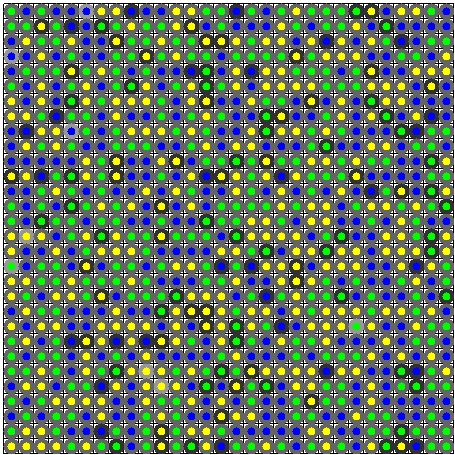
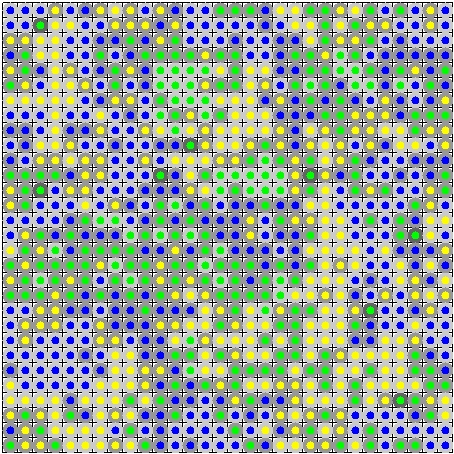
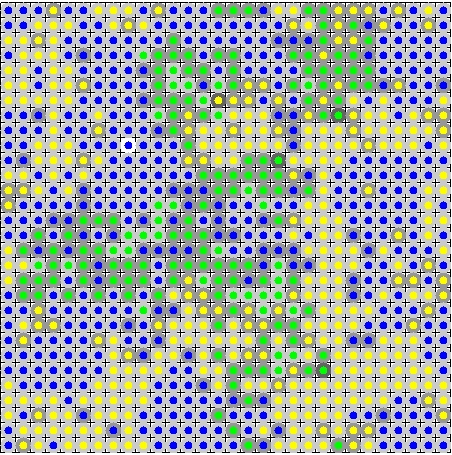
Figure 1. A single simulation run with m=3, s=10 and ha=0.05. The figure shows the grid at the beginning of the simulation (left, t=0), after the burn in phase (middle, t=200) and at the end of the simulation (right, t=10000). Each grid cell represents the material component as a coloured circle (blue, green, yellow) and the coherence of the individual's practice with a grey background (black: coherence=0, white: coherence=1). In the beginning of the run, coherence is low (dark background) and materials are randomly distributed because of the random initialization. Over time clustering and coherence increase. 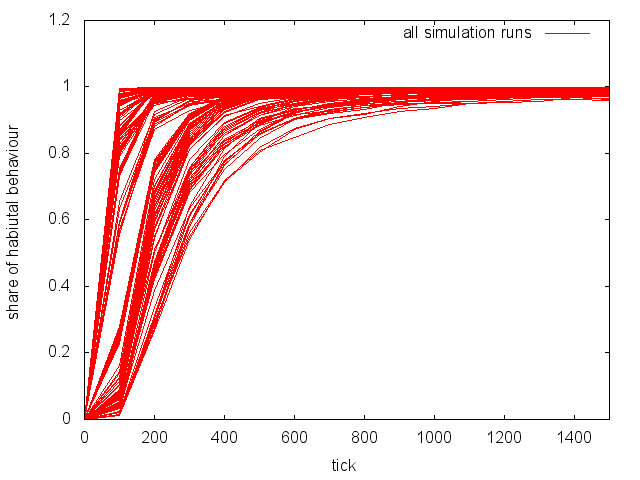
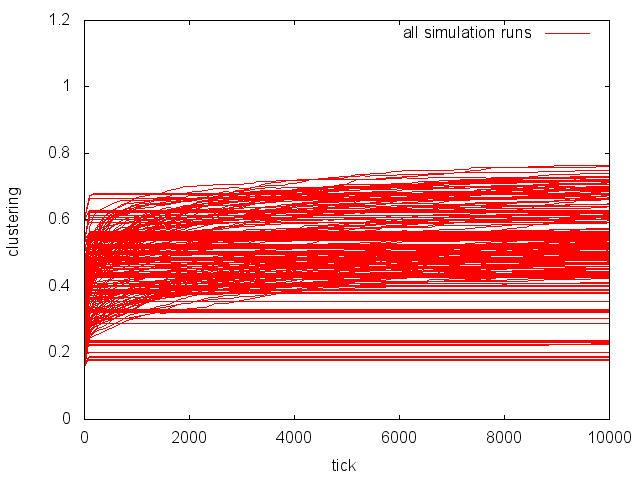
Figure 2. Share of habitual behaviour (left, first 1500 time steps) and clustering (right) for all simulation runs. Output is generated and plotted every 100 time steps. Influence of parameters
- 5.5
- Figure 3 shows that the final level of habitual behaviour is close to 100% with almost no variability for all parameter combinations. Clustering is almost exclusively influenced by the strength of the communication s. For high s (s=10) the average clustering is 0.626 which is significantly above the random expectation[8]. The number of available material components m increases the variability of clustering in the runs but has almost no observable effect on the average clustering. The habit acquisition speed ha has no observable effect on both, the average and variability of simulation results, but as can be expected has a distinct effect on the speed with which habits develop initially (Figure 4).
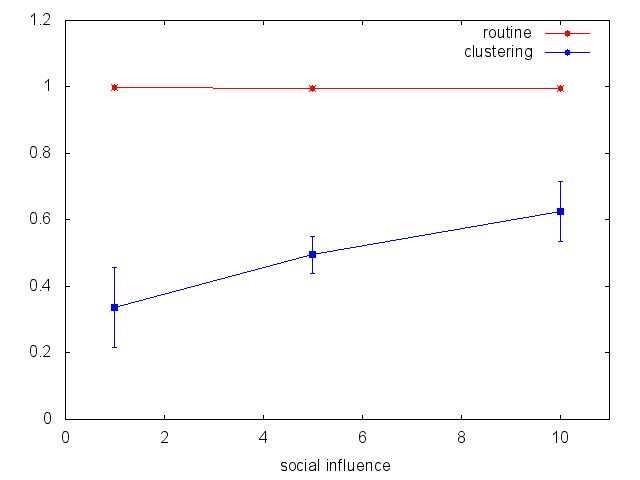
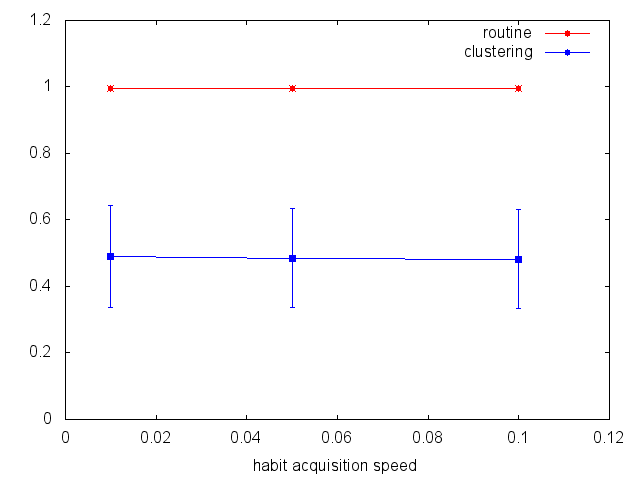
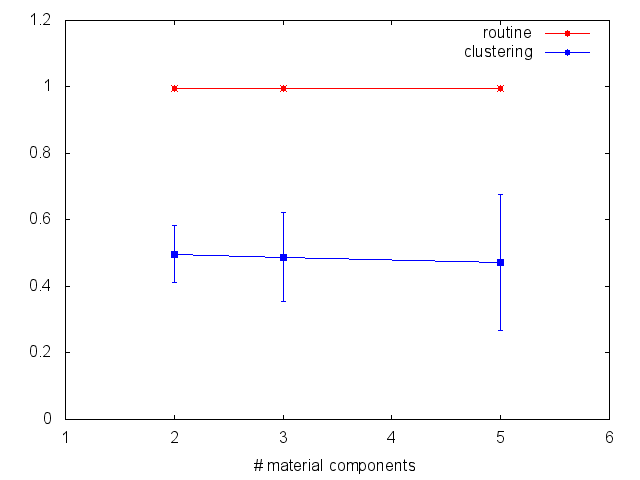
Figure 3. Average and standard deviation of all 270 simulations at the end of the simulations. (Red: average number of individuals acting habitually; Blue: clustering) 
Figure 4. The habit acquisition speed ha influences the time required until almost all individuals act habitually. The figure illustrates the 27 averages of each of the 10 runs with the same parameters (first 1000 time steps only, and the output is generated every 100 steps). Lock-in
- 5.6
- It has been shown in Figure 2 that clustering increases significantly only for some parameter combinations. Figure 5 illustrates the grid for three time steps for a simulation run with lock-in (cf. Figure 1). While coherence and habitual behaviour increase, the clustering remains low. Figure 6 reveals that the system gets locked-in in a state of low clustering if either the number of available materials is low (n=2) or the communication effect is very low (s=1). This will be interpreted and further discussed in the next section.
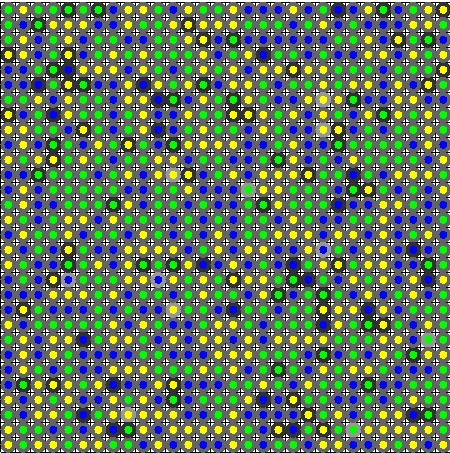
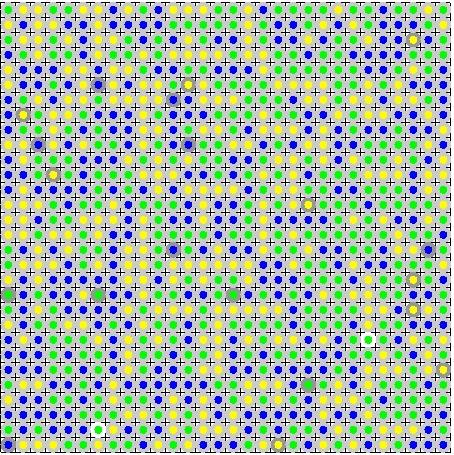
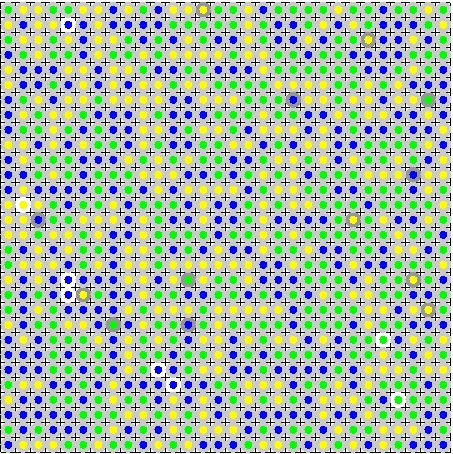
Figure 5. A single simulation run with m=3, s=1 and ha=0.05. The figure shows the grid at the beginning of the simulation (left, t=0), after the burn in phase (middle, t=200) and at the end of the simulation (right, t=10000). Each grid cell represents the material component as a coloured circle (blue, green, yellow) and the coherence of the individual's practice with a grey background (black: coherence=0, white: coherence=1). In the beginning of the run coherence is low (dark background) and materials are randomly distributed because of the random initialization. Over time coherence increases but clustering remains low (clustering=0.430 at t=0 and clustering=0.447 at end of simulation). 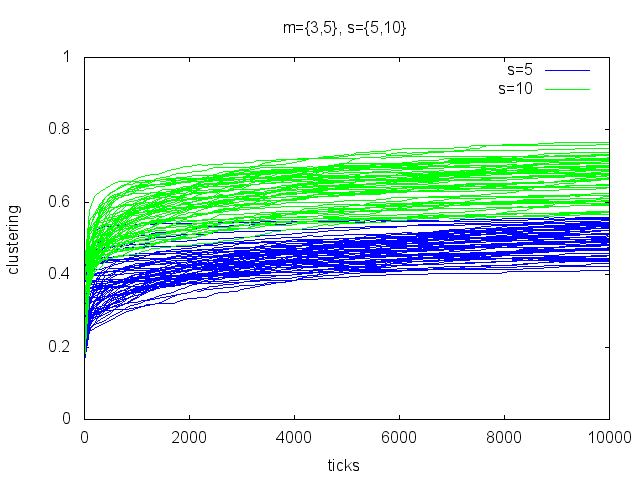
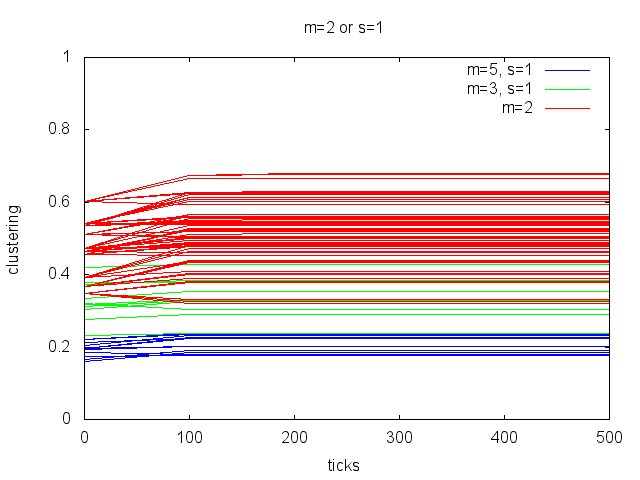
Figure 6. Separation of simulation runs according to gradual increase of clustering after burn-in phase (left) and lock-in (right, first 500 steps only).
 Interpretation of simulation results and discussion
Interpretation of simulation results and discussion
- 6.1
- The overall finding from this modelling exercise is that the proposed conceptual framework provides a potential explanation for the emergence of social practices. The simulation model that is based on the conceptual framework is able to generate socially shared routine behaviour for a wide range of parameter combinations. Individuals act habitually and clustering is significantly above the random expectation, i.e. the behaviour is similar among peers.
- 6.2
- The stability of social practices is generated by the model as follows: after the burn-in phase the most suitable material available in the local neighbourhood has been adopted by each individual and high levels of coherence and habit become established through the intra-individual processes (adapt meaning to material, adapt competence to material and habituation). Consequently the individuals act habitually most of the time and do not consider a change of behaviour. Even if by chance a deliberate choice is initiated no change of material occurs because meaning and competence are adapted to the currently used material and hence this material yields the highest coherence value and is preferred over others available in the local neighbourhood. Therefore no change of material occurs as long as meaning and competence remain static. Competence is not addressed by processes external to the individual and therefore the exchange of meaning with peers is the only source for potential behavioural change (in the current model version).
- 6.3
- The model also yields interesting insights into the mechanisms generating and blocking change in behaviour because after the burn-in phase the model shows two qualitatively different behaviours: 1) exchange of meaning is sufficient to initiate a change of behaviour in some individuals and hence clustering increases over time, and 2) the system gets locked-in after the burn-in phase. As described above, the system gets locked in if either the number of available materials is very low or the communication effect is weak. This can be understood as lock-in due to missing competence as explained in the following. Be competencei and meaningi the respective components of individual i and be mold the material currently adopted by i. In order to initiate an adoption of mnew coherence of a practices including mnew must exceed coherence with mold. After the burn-in phase |meaningi – mold| and |competencei – mold| are very low because adapt meaning to material and adapt competence to material have aligned the components. Assuming that meaningi changes through communication with peers and aligns more closely with mnew, then coherence(mnew) > coherence(mold) if and only if |meaningi − mold| > |competencei − mnew|, i.e. if meaning changes so significantly that it is more distant from mold than competence is from mnew. This will only be the case if there is a strong influence on meaning from peers and the competence necessary for mnew is not too different from that necessary for mold. The first condition results if the communication effect s is sufficiently strong. The second condition depends on the random initialization of the various material component bitstrings. But with a high probability the Hamming distances to the next similar material become the lower the more materials are available and therefore changes of material become easier. If an actual adoption of mnew is blocked through missing competence then the process adapt meaning to material reverses the externally-induced change in meaning and reconstitutes the coherence of the practice around mold. The result is that some exchange of meaning may temporarily "distort" the habitual behaviour of individuals. But if exchange of meaning does not initiate a change in behaviour then individuals tend to forget about their change of mind and return to "normal" in both, behaviour and meaning – the opportunity for behavioural change vanishes over time.[9]
- 6.4
- Referring back to the case of travelling to work at the outset of this article, an illustrative example of this lock-in effect is that a campaign on the environmental consequences of driving by car may induce in some individuals in the target group to change their evaluation of different travelling modes. Such individuals may value the bicycle over the car as a travelling mode. However, once the alternative mode of travel shall be enacted, some individuals may realize that they are not physically fit enough to reach the destination without being worn out and perspiring heavily when they arrive (while it would pose no difficulty for a person going by bicycle regularly), so these individuals decide to continue using the car instead. After a period of time the intention to travel by bicycle is forgotten and the lessons learned about environmental consequences are dismissed.
- 6.5
- This lock-in due to missing competence that blocks change in social practices was not anticipated when the conceptual framework was designed and its identification constitutes an added value of the simulation modelling exercise. It points towards difficulties in changing behaviour that cannot be captured in models in which individuals only interact via mutual observation of behaviour (Arthur 1994; e.g. Axelrod 1986; Granovetter 1978; Valente 1995) or based on behaviour and meaning[10] (e.g. Ajzen & Fishbein 1980; Schwarz & Ernst 2009). In other words, the integration of three co-evolving components – meaning, material and competence – that determine the involvement of individuals in practices over time adds new aspects to the understanding of behavioural change. The added value of an abstract model like the one presented is to identify emergent effects like this lock-in due to missing competence which may be relevant also in real systems. The awareness of such mechanisms can then be used to inform empirical studies and more empirically based models.
 Conclusions and outlook
Conclusions and outlook
- 7.1
- In this paper a conceptual framework and a corresponding simulation model to investigate the emergence of social practices have been presented. The framework has been based on and extended current concepts of social practice theories. The main results are twofold. First, the simulation model is able to generate social practices what confirms that the conceptual framework captures relevant components and processes and therefore constitutes a suitable starting point for studying social practices. Second, a mechanism for behavioural lock-in has been identified that provides new insights into the widely acknowledged difficulties of changing social practices and accordingly consumption habits. The model identifies the interplay of the strengths of exchange between individuals and the feasibility of alternative modes of behaviour to be important for variability as well as stability of social practices. Preliminary conclusions suggest that in order to change social practices discussions regarding the respective practices should be stimulated and practicable alternatives should be provided (e.g. through bridging technologies such as hybrid cars) that do not demand too large a leap in behaviour and the associated required competence.
- 7.2
- The framework and the simulation model provide several possibilities for further extensions which will be conceptualised and implemented in future work. Among these are the incorporation and comparison of different network structures and the consideration of social norms in the model. Furthermore, the intention is to use this abstract model to develop more specific models tailored to empirical cases.
 Notes
Notes
-
1Social practice theories offer a broad range of interesting questions that could be pursued. This paper and model address (only) one issue, namely understanding a single social practice as an emergent phenomenon that is generated by underlying elements and processes. Since the social practice shall be generated it cannot be an element of the model itself.
2Except their location in the network of individuals (see section on implementation).
3See below for the connection between coherence and habitual behavior.
4The model code is available at http://www.openabm.org/model/3817
5JASSS and CMOT were searched on January 3rd 2013 using "social practice", "Reckwitz", "Shove" and "Giddens" and the search results were first checked by title and when indicated by abstract.
6Coherence is "very low" is operationalized as (coherence ∈ [0, 0.5]) because the coherence of three random bitstrings is somewhat lower than 0.5
7The moving average relates to each time step the average of the target variable over the last d steps. In the simulations reported here d=50.
8For runs with m=2 the random expectation is clustering =0.5, for m=3 it is clustering=0.33 and for m=5 it is clustering=0.2. All m are simulated 90 times. Therefore the random expectation on average is clustering=(0.5+0.33+0.2)/3=0.344
9This mechanism blocking change in social practices has been even stronger in a previous model version in which coherence has been calculated as the number of bits on which all three components of a practice are similar divided by the total length of the bitstrings (cf. Holtz 2012b). The current operationalization of coherence presented in this paper has been found to be more appropriate after an in-depth investigation of the underlying empirical processes (cf. Holtz 2012a).
10Broadly capturing concepts such as preferences, values, beliefs, etc.
 References
References
-
AARTS, H., Verplanken, B., & Knippenberg, A. (1998). Predicting Behavior From Actions in the Past: Repeated Decision Making or a Matter of Habit? Journal of Applied Social Psychology, 28(15), 1355–1374. [doi:10.1111/j.1559-1816.1998.tb01681.x]
AJZEN, I., & Fishbein, M. (1980). Understanding attitudes and predicting social behavior. Englewood Cliffs, NJ: Prentice-Hall.
ANDERSON, J. R. (1982). Acquisition of cognitive skill. Psychological Review, 89(4), 369–406. [doi:10.1037/0033-295X.89.4.369]
ARTHUR, B. W. (1994). Increasing returns and path dependence in the economy. The University of Michigan Press.
AXELROD, R. (1986). An Evolutionary Approach to Norms. The American Political Science Review, 80(4), 1095–1111. [doi:10.2307/1960858]
AXELROD, R. (1997). The Dissemination of Culture: A Model with Local Convergence and Global Polarization. The Journal of Conflict Resolution, 41(2), 203–226. [doi:10.1177/0022002797041002001]
CHALMERS, D. (2006). Strong and Weak Emergence. In P. Clayton & P. Davies (Eds.), The Re-emergence of Emergence. Oxford University Press. Retrieved from: https://mywebspace.wisc.edu/lshapiro/web/Phil554_files/Chalmers-Emergence.pdf
COOPER, J. (2007). Cognitive Dissonance - Fifty Years of a Classic Theory. Sage Publications Ltd.
EMMECHE, C., Køppe, S., & Stjernfelt, F. (2000). Levels, Emergence, and Three Versions of Downward Causation. In P. B. Andersen, C. Emmeche, N. O. Finnemann, & P. V. Christiansen (Eds.), Downward Causation, Minds, Bodies and Matter (pp. 13–34). Aarhus University Press.
EPSTEIN, J. M., & Axtell, R. (1996). Growing artificial societies: social science from the bottom up. Complex adaptive systems. Washington, D.C.: Brookings Institution Press; MIT Press.
FESTINGER, L., & Carlsmith, M. (1959). Cognitive Consequences of Forced Compliance. Journal of Abnormal and Social Psychology, 58, 203–210. [doi:10.1037/h0041593]
GIDDENS, A. (1984). The Constitution of Society: Outline of the Theory of Structuration. Berkeley: University of California Press.
GILBERT, N. (2002). Varieties of Emergence. Workshop on Agent 2002 Social Agents: Ecology, Exchange, and Evolution Conference. Retrieved from http://www.soc.surrey.ac.uk/staff/ngilbert/ngpub/paper148_NG.pdf
GRANOVETTER, M. (1978). Threshold Models of Collective Behaviour. American Journal of Sociology, 83(6), 1420–1443. [doi:10.1086/226707]
GRAM-HANSSEN, K. (2010). Standby Consumption in Households Analyzed With a Practice Theory Approach. Journal of Industrial Ecology, 14(1), 150–165. [doi:10.1111/j.1530-9290.2009.00194.x]
HALKIER, B., Katz-Gerro, T., & Martens, L. (2011). Applying practice theory to the study of consumption: Theoretical and methodological considerations. Journal of Consumer Culture, 11(3), 3–13. [doi:10.1177/1469540510391765]
HEATHCOTE, A., Brown, S., & Mewhort, D. J. (2000). The power law repealed: the case for an exponential law of practice. Psychonomic bulletin & review, 7(2), 185–207. [doi:10.3758/BF03212979]
HOFMANN, S. (2009). Dynamik sozialer Praktiken: Simulation gemeinsamer Unternehmungen von Frauengruppen. VS Verlag für Sozialwissenschaften. [doi:10.1007/978-3-531-91807-5]
HOLTZ, G. (2012a). Coherence of social practices: the case of meat consumption. Unpublished working paper. http://www.usf.uos.de/institut/publikationen/forschungsgruppen/rem.html
HOLTZ, G. (2012b). An agent-based model of social practices. ESSA 2012 Proceedings.
JACKSON, T. (2005). Motivating Sustainable Consumption – a review of evidence on consumer behaviour and behavioural change. A report to the Sustainable Development Research Network.
JAGER, W. (2003). Breaking " bad habits": a dynamical perspective on habit. In L. Hendrickx, W. Jager, & L. Steg (Eds.), Human Decision Making and Environmental Perception. Understanding and Assisting Human Decision Making in Real-life Settings. University of Groningen. Retrieved from: http://www.rug.nl/staff/w.jager/jager_habits_chapter_2003.pdf
KIM, J. (1999). Making sense of emergence. Philosophical Studies, 95, 3–36. [doi:10.1023/A:1004563122154]
MCPHERSON, M., Smith-lovin, L., & Cook, J. M. (2001). Birds of a Feather: Homophily in Social Networks. Annual Review of Sociology, 27(2001), 415–444. [doi:10.1146/annurev.soc.27.1.415]
MOLONEY, S., Horne, R. E., & Fien, J. (2010). Transitioning to low carbon communities - from behaviour change to systemic change: Lessons from Australia. Energy Policy, 38, 7614–7623. [doi:10.1016/j.enpol.2009.06.058]
NEWELL, A., & Rosenbloom, P. S. (1980). Mechanisms of skill acquisition and the law of practice. Computer Science Department, Carnegie Mellon University. Paper 2387. Retrieved from http://repository.cmu.edu/compsci/2387
ORESKES, N., Shrader-Frechette, K., & Belitz, K. (1994). Verification, validation, and confirmation of numerical models in the earth sciences. Science, 263(5147), 641–646. [doi:10.1126/science.263.5147.641]
Read, S., & Simon, D. (2012). Parallel Constraint Satisfaction as a Mechanism for Cognitive Consistency. In B. Gawronski & F. Strack (Eds.), Cognitive Consistency: A Fundamental Principle in Social Cognition (pp. 66–86). The Guilford Press.
RECKWITZ, A. (2002). Toward a Theory of Social Practices. European Journal of Sociology, 5(2), 243–263.
RØPKE, I. (2009). Theories of practice - New inspiration for ecological economic studies on consumption. Ecological Economics, 68, 2490–2497. [doi:10.1016/j.ecolecon.2009.05.015]
SAWYER, K. (2003). Artificial Societies – Multiagent Systems and the Micro-Macro Link in Sociological Theory. Sociological Methods & Research, 31(3), 325–363. [doi:10.1177/0049124102239079]
SCHATZKI, T. (2002). Site of the Social?: A Philosophical Account of the Constitution of Social Life and Change. Pennsylvania State University Press.
SCHWARZ, N., & Ernst, A. (2009). Agent-based modeling of the diffusion of environmental innovations — An empirical approach. Evolutionary Methodologies for Analyzing Environmental Innovations and the Implications for Environmental Policy, 76(4), 497–511. [doi:10.1016/j.techfore.2008.03.024]
SHOVE, E. (2004). Sustainability, system innovation and the laundry. In B. Elzen, F. Geels, & K. Green (Eds.), System Innovation and the Transition to Sustainability: Theory, Evidence and Policy (pp. 76–94). Cheltenham: Edward Elgar. [doi:10.4337/9781845423421.00014]
SHOVE, E., & Pantzar, M. (2005). Consumers, Producers and Practices. Journal of Consumer Culture, 5(1), 43–64. [doi:10.1177/1469540505049846]
SHOVE, E., & Walker, G. (2010). Governing transitions in the sustainability of everyday life. Research Policy, 39, 471–476. [doi:10.1016/j.respol.2010.01.019]
SPAARGAREN, G., Martens, S., & Beckers, T. (2006). Sustainable technologies and everyday life. In P. P. Verbeek & A. Slob (Eds.), User behaviour and Technology Development: shaping Sustainable Relations Between Consumers and Technologies (pp. 107–118). Dordrecht: Springer. [doi:10.1007/978-1-4020-5196-8_11]
SQUAZZONI, F. (2008). The Micro-Macro Link in Social Simulation. Sociologica, 1.
STEG, L., & Tertoolen, G. (1999). Sustainable Transport Policy: The Contribution from Behavioural Scientists. Public Money & Management, January–May, 63–69. [doi:10.1111/1467-9302.00154]
TERTOOLEN, G., Van Kreveld, D., & Verstraten, E. C. H. (1998). Psychological resistance against attempts to reduce private car use. Transportation Research A, 32(3), 171–181. [doi:10.1016/s0965-8564(97)00006-2]
TUKKER, A., Cohen, M. J., Hubacek, K., & Mont, O. (2010). The Impacts of Household Consumption and Options for Change. Journal of Industrial Ecology, 14(1), 13–30. [doi:10.1111/j.1530-9290.2009.00208.x]
TUOMELA, R. (2002). The philosophy of social practices?: a collective acceptance view. Cambridge University Press. [doi:10.1017/cbo9780511487446]
VALENTE, T. W. (1995). Network Models of the Diffusion of Innovations. Cresskill, New Jersey: Hampton Press.
WARDE, A. (2005). Consumption and Theories of Practice. Journal of Consumer Culture, 5(2), 131–153. [doi:10.1177/1469540505053090]
WINDRUM, P., Fagiolo, G., & Moneta, A. (2007). Empirical Validation of Agent-Based Models: Alternatives and Prospects. Journal of Artificial Societies and Social Simulation, 10(2). https://www.jasss.org/10/2/8.html